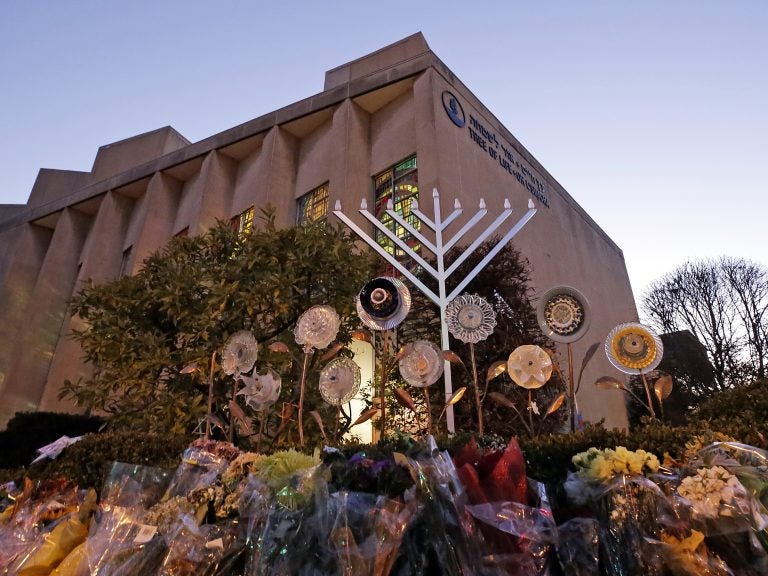Report: Anti-Semitic incidents dip in Pennsylvania, Delaware and New Jersey
Despite a nationwide drop of anti-Semitic incidents in 2018, the Anti-Defamation League recorded the second-highest number of those events in the last decade.

A menorah is installed outside the Tree of Life Synagogue in Pittsburgh on the first night of Hanukkah.The synagogue was the site of a mass shooting in October. It was one of a number of tragedies and revelations that made 2018 a difficult year for the city of Pittsburgh. (Gene J. Puskar/AP Photo)
Pennsylvania, New Jersey, and Delaware had fewer anti-Semitic incidents in 2018 compared with 2017, according to a new audit from the Anti-Defamation League.
Released Tuesday — days after a deadly shooting inside a synagogue outside San Diego and a day before Holocaust Remembrance Day — the report is encouraging, but nothing to celebrate, said ADL regional director Nancy Baron-Baer.
The New York-based organization has completed annual audits of anti-Semitic incidents since 1979.
The numbers in Pennsylvania remain 41% higher than the ADL’s historic average for the state over that four-decade span. New Jersey’s are up 20%.
“We can’t let the elevated numbers that we’re seeing, in comparison to decades past, become the new normal,” said Baron-Baer. “We as individuals, we as community members, we as faith leaders, as law enforcement officials, as elected officials, we have to push back day in and day out.”
Why have anti-Semitic incidents been on the rise?
Baron-Baer has two answers: politics and the internet.
“Extremists feel emboldened. They feel emboldened in ways they never did in the past. That’s why we see so many incidents with ties to white supremacist ideologies,” she said. “And someone can sit in their bedroom in a pair of pajamas and have their vitriol, their hatred, spread to millions across the globe.”
Delaware saw the biggest statistical drop, going from 13 incidents in 2017 to just two one year later.
New Jersey went from 208 incidents to 200, the third-highest total in the country in 2018. Only California (341) and New York (340) had more.
Pennsylvania recorded 89 incidents, including October’s deadly shooting in the Tree of Life Synagogue in Pittsburgh. That’s down from 96 in 2017.
Arlene Fickler, chair of the Jewish Community Relations Council of the Jewish Federation of Greater Philadelphia, takes “little comfort” in the decrease. She grew up during the Civil Rights Movement of the 1960s and had hoped the country would be more tolerant by now.
“I had hoped, and deeply believed, that the United States was coming to live much more fully the hopes and aspirations of our founders in terms of equality for all,” said Fickler. “I find that what we’ve seen in the last two years in this country to be deeply troubling.”
The ADL recorded 1,879 anti-Semitic incidents across the U.S. in 2018, down from 2017, when the organization recorded 1,986.
Even with the drop, the total is the ADL’s second highest in the last decade and the third highest since 1979.
The vast majority (1,840) of the incidents in 2018 were categorized as either harassment or vandalism. A smaller chunk (39) were categorized as assault, though that figure is more than double the tally for 2017.
These incidents happened in synagogues, businesses, and cemeteries, but also on college campuses and at elementary and high schools — both Jewish and non-Jewish.
More than 10% of last year’s total could be “attributed to known extremist groups or individuals inspired by extremist ideology,” according to the audit. That is the highest total since 2004.
WHYY is your source for fact-based, in-depth journalism and information. As a nonprofit organization, we rely on financial support from readers like you. Please give today.





